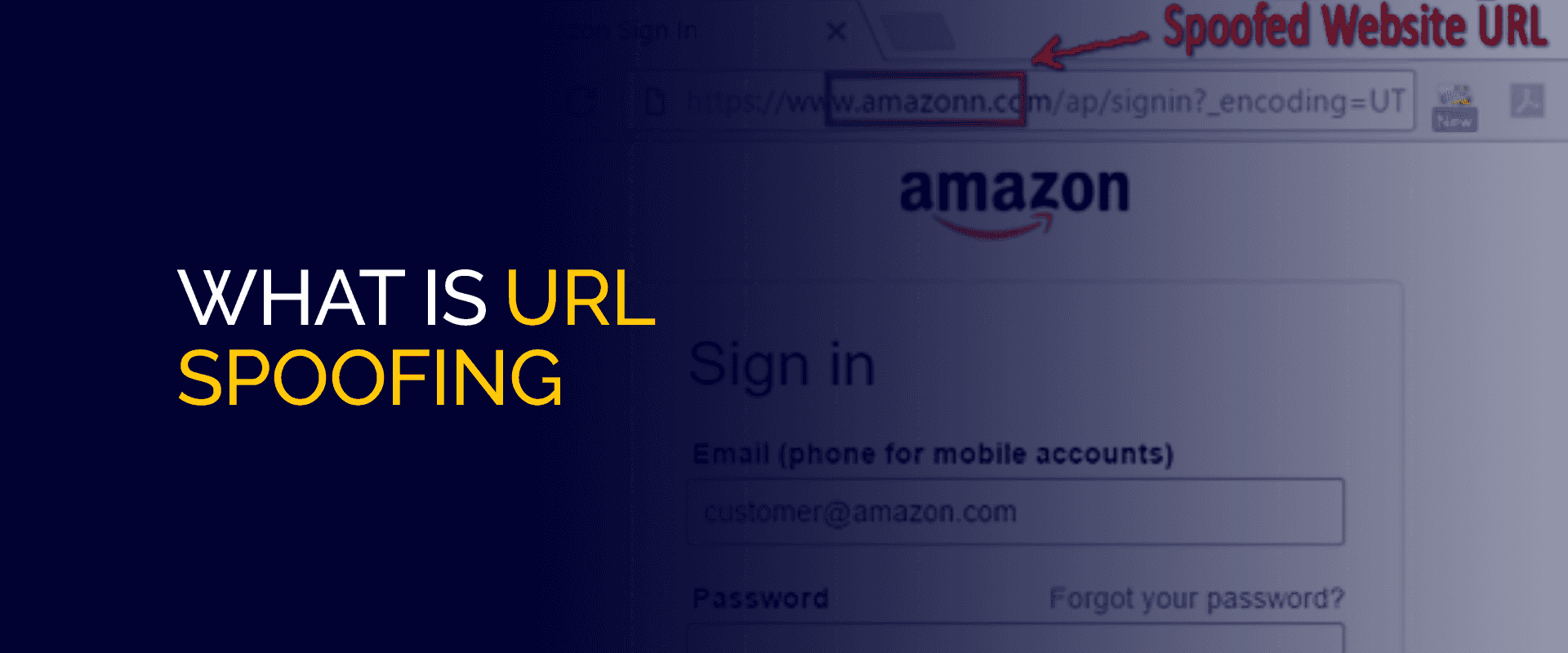

Get 93% OFF on Lifetime
Exclusive Deal
Don’t miss out this deal, it comes with Password Manager FREE of cost.
Get 93% off on FastestVPN and avail PassHulk Password Manager FREE
Get This Deal Now!By Janne Smith No Comments 7 minutes
Facebook, Microsoft, PayPal, and Google – all have been highly targeted companies for URL spoofing attacks. While both spoofing and Phishing differ, they’re often confused as the same. However, the intent for both is the same: to illegally gather your personal information, which primarily leads to monetary benefits.

“You can now travel to Bali for $100; click here for the travel details!” Doesn’t that look like a deal that’s too hard to miss? With a rapid increase in every celebrity glorifying Bali trips, deep inside, we all want to visit it once. However, notifications and links only mark the beginning of a spoofing attack.
Sometimes, data loss straightaway marks a start from the moment you click the spoof link, and sometimes, this loss awaits a few website redirections. In both cases, nobody can sleep the horror of seeing their money draining from their bank accounts.
Looking at the brighter side, there are ways to mitigate a link spoofing attack. But before that, you need to understand how these attacks work. This article covers all about it. Let’s dive in!
Note: Your information is only safe online once you use a reliable VPN, like FastestVPN, that conceals your IP address. By connecting to a different server location, the VPN masks your online activities and disguises your visible location as original.
Moreover, it protects you from the threat of URL spoofing. When your information is safe from leaking online, the chances of spoofing are reduced.
URL spoofing is the attempt of a black hat to send a spoof link that disguises itself as a legitimate source. And the primary aim is to steal your data when you click on those links.
The threat doesn’t stick to the spoof link only. Instead, it stretches till your journey to the site of the spoof URL. Even the spoof URL looks like the home page of some known business you’ve trusted. It then traps you into providing your sensitive information. And, the moment you do so, you become the victim of a cyber attack.
Generally, a spoofed site contains:
According to an FBI report, in 2022, there were thousands of large-scale URL spoofing attacks where hackers disguised themselves as large companies to dupe their victims.
Generally, a spoof link uses an http:// URL instead of https://, where “S” stands for “secure.” A spoofed site always comes with generous global traffic. The spoof link is sent to people through emails and text messages. Primarily, the spoof URL offers an irresistible deal you can’t afford to miss out on – marking the red flag for a spoofing attack.
You, as a travel enthusiast, are on a lifelong search for the best travel deals. From exploring the deceptively real beaches of Miami to exploring the North Pole – you love traveling the world.
One day, you receive an email stating:
“Exciting News! You’ve been selected as one of our exclusive winners for a spectacular 1-week Euro tour! Seize the moment and register now by clicking the link below. Act fast – this incredible offer expires in just one hour! Don’t miss out on the chance to embark on an unforgettable adventure!
When you click the spoof URL, you’re about to lose your personal information, primarily leading to a monetary loss through that spoof URL. In a few cases, you’re likely to fall victim to a spoofing attack right when you click the spoof link. Or, if you’re lucky, you can be spared until you register and provide sensitive information on that spoof link.
Here are the types of spoofing attacks:
This common form of spoofing targets victims through email communication. The sender adopts the appearance of a trusted source, utilizing an email address resembling the authentic one.
This may involve mimicking a recognized email domain or slightly altering the address as a spoof URL.
Like Caller ID Spoofing, Text Message Spoofing entails attackers sending SMS messages using another person’s phone number or sender ID. The malicious actor attempts to conceal their identity using an alphanumeric sender ID.
A prevalent spoofing method is often coupled with deceptive emails containing site links. Website spoofing entails creating a counterfeit website’s spoof URL closely mirroring a trusted or well-known one.
These sites typically feature a login page where victims are prompted to enter sensitive information.
The domain name system (DNS) is a security layer for website access. DNS spoofing involves deceptive practices to assure users that the displayed spoofing URL corresponds to the intended website.
Spoofing and Phishing, while interconnected, represent distinct cybersecurity threats. Spoofing manipulates communication origins, like emails or websites with a spoof URL, creating misleading impressions.
Phishing, a broader strategy, frequently employs spoofing by masquerading as trustworthy entities to deceive individuals into revealing sensitive information. According to Statista, in the last quarter of 2022, approximately 1.35 million distinct phishing websites were identified globally, indicating a marginal uptick compared to the previous quarter.
While spoofing is a deceptive technique, not all instances involve malicious intent. Phishing, however, inherently seeks to exploit individuals by fraudulently soliciting confidential data. Both pose substantial risks in the cybersecurity landscape.
Forbes mentions that Phishing is a widespread cybercrime, with over 500 million reported incidents in 2022. However, spoofing and phishing are often used synonymously despite their major differences.
Here are the primary differences between phishing and spoofing:
| Phishing | Spoofing |
| It aims to pilfer information. | It imitates another person’s identity. |
| Considered fraud as it entails the theft of information. | The aim is not to commit fraud but to replicate the victim’s email or phone number. |
| It’s conducted through the utilization of social engineering methods. | Encourages the installation of malicious software on the victim’s computer. |
Here are the primary signs of a spoofing attack:
The http:// spoofing URL often indicates that the site’s connection isn’t secure, and there are chances of it stealing your sensitive information. On the other hand, a secure site always has an https:// URL, where the “s” stands for “secure.”
A spoofing attack always has a drool-worthy offer that is often hard to resist. It may be about a hard-to-accept deal, which can revolve around gift cards, travel plans, or some gifts. And they usually come with a deadline that encourages urgency.
Most black hats have all the tech expertise but none of the grammar. You’ll likely see spelling errors, grammar issues, and suspicious contact information, which raise a clear red flag.
If you’ve selected what appears to be a genuine link and the website mirrors a trusted source, it’s crucial to verify if it employs HTTPS. If not, it is advisable to exit promptly.
According to a report, for an organization with 1-250 employees, approximately one out of every 323 emails received is malicious. Conversely, for organizations ranging from 1001 to 1500 employees, the ratio shifts to one malicious email per 823 received.
Before falling victim to these emails, here are ways to mitigate a spoofing attack:
Ensure that you set up the advanced security protocols for your emails, such as the two-factor authentication (2FA) and others. It helps you to stay guarded from all email spoofing attacks.
Using a reliable service, like FastestVPN, is now a requisite when staying online. Once you connect to a VPN server, you can leverage its unmatched features, like the IKEv2, WireGuard, L2TP, etc. With these, you’re ensured of never worrying about data leaks or becoming a victim of a spoofing attack.
If you’ve selected a link that appears genuine and the website resembles a trusted source, verifying if the spoofing URL utilizes HTTPS is essential. If not, it’s recommended to leave the site immediately.
Here are the top signs that indicate that someone's spoofing you: An example of website spoofing is an attacker creating a website mainly for spoofing purposes. A malicious spoof link draws you to the website and tricks you into providing your personal information. The 3 common types of spoofing are caller ID spoofing, SMS spoofing and domain spoofing. Spoofing isn't directly malware. Instead, it's an attempt to spread malware. FAQs - URL Spoofing
How would you know if someone is spoofing you?
What is an example of website spoofing?
What are 3 common types of spoofing?
Is spoofing a type of malware?
Distinguished from Phishing, URL spoofing aims to deceive users into revealing personal information, often leading to financial losses. Spoofed sites mimic trusted sources, utilizing stolen logos and familiar branding.
Signs of a spoofing attack include HTTP spoofing URL, enticing deals, grammatical errors, and replication of known brands. However, mitigation measures primarily involve using a reliable VPN, like the FastestVPN.
Take Control of Your Privacy Today! Unblock websites, access streaming platforms, and bypass ISP monitoring.
Get FastestVPN
© Copyright 2025 Fastest VPN - All Rights Reserved.


Don’t miss out this deal, it comes with Password Manager FREE of cost.
This website uses cookies so that we can provide you with the best user experience possible. Cookie information is stored in your browser and performs functions such as recognising you when you return to our website and helping our team to understand which sections of the website you find most interesting and useful.
Strictly Necessary Cookie should be enabled at all times so that we can save your preferences for cookie settings.
If you disable this cookie, we will not be able to save your preferences. This means that every time you visit this website you will need to enable or disable cookies again.